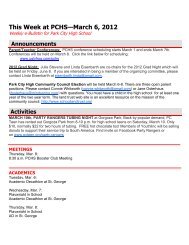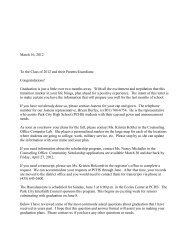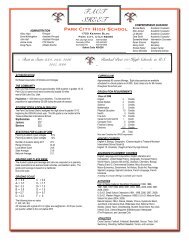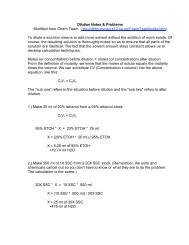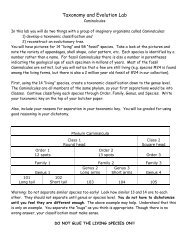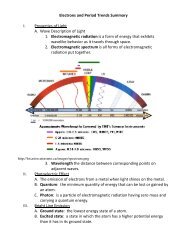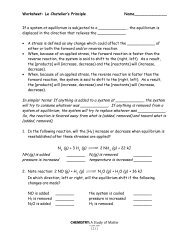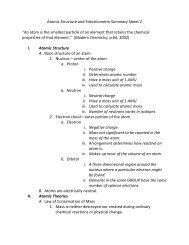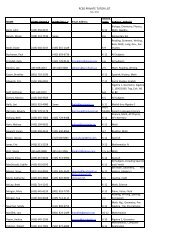AP Language and Composition
AP Language and Composition
AP Language and Composition
Create successful ePaper yourself
Turn your PDF publications into a flip-book with our unique Google optimized e-Paper software.
<strong>AP</strong> <strong>Language</strong> <strong>and</strong> <strong>Composition</strong><br />
09-10<br />
Mr. Potts<br />
Overview of the Course:<br />
The <strong>AP</strong> course in English <strong>Language</strong> <strong>and</strong> <strong>Composition</strong> helps students to become skilled<br />
readers of prose written in a variety of periods, disciplines, <strong>and</strong> rhetorical contexts <strong>and</strong> to<br />
become skilled writers who compose for a variety of purposes. The purpose of the course<br />
is to enable students to read complex texts with underst<strong>and</strong>ing <strong>and</strong> to write prose of<br />
sufficient richness <strong>and</strong> complexity to communicate effectively with mature readers. Both<br />
their writing <strong>and</strong> their reading should make students aware of the interactions among a<br />
writer's purposes, audience expectations, <strong>and</strong> subjects as well as the way certain<br />
conventions <strong>and</strong> the resources of language contribute to effectiveness in writing. The<br />
acquisition of these reading <strong>and</strong> writing skills should prepare students to perform<br />
successfully on the <strong>AP</strong> Examination on English <strong>Language</strong> <strong>and</strong> <strong>Composition</strong> in May, 2007<br />
Overview of the <strong>AP</strong> Exam:<br />
According to Hephzibah Roskelly, Chief Faculty Consultant of the Advanced Placement<br />
Program administered by The College Board, "The <strong>AP</strong> <strong>Language</strong> <strong>and</strong> <strong>Composition</strong> Exam<br />
consists of two parts: a multiple-choice section that tests the c<strong>and</strong>idate's underst<strong>and</strong>ing of<br />
passages that have been drawn from a variety of periods <strong>and</strong> written in a variety of styles,<br />
<strong>and</strong> a free-response section that requires the c<strong>and</strong>idate to write essays on specified topics.<br />
Together, these sections test the full range of the student's ability to recognize <strong>and</strong> use<br />
rhetorical strategies, to analyze texts, <strong>and</strong> to make his or her own arguments."<br />
Mr. Potts’ Expectations:<br />
Summed up best by the writer Haruki Murakami:<br />
“These are the things that really frighten me; what I absolutely fear <strong>and</strong> loathe: Narrow<br />
minds devoid of imagination. Intolerance, theories cut off from reality, empty<br />
terminology, usurped ideals, inflexible systems. Of coarse it’s important to know what’s<br />
right <strong>and</strong> what’s wrong. Individual errors in judgment can usually be corrected. As long<br />
as you have the courage to admit mistakes, things can be turned around. But intolerant,<br />
narrow minds with no imagination are like parasites that transform the host, change<br />
form, <strong>and</strong> continue to thrive. They’re a lost cause, <strong>and</strong> I don’t want anyone like that<br />
coming in here!”<br />
Materials Needed:<br />
• At least one fluorescent colored “hi-liter” marker<br />
• Any “Writer’s H<strong>and</strong>book,” literary term book, or rhetorical device reference<br />
book.<br />
• Stickies/Post-it Notes<br />
• Four non-fiction outside reading books. One for each quarter.<br />
• A good sized three ring binder that will serve as a Writing Portfolio/Study Guide<br />
which will be divided into the following sections:<br />
1. Terminology – You will be given at least 4 different colored sheets that contain terms<br />
that you must commit to memory. We will have “90/90” quizzes until you can<br />
demonstrate mastery of each list.
2. Vocabulary – This is a collection of words that I (Mr. Potts) want to see in your<br />
essays <strong>and</strong> other assorted writing assignments that we will do throughout the year.<br />
Although mastery of these words is not required, you will see the benefit in your grade if<br />
you choose to learn them.<br />
3. Collection of My Writing—This section should contain everything that you write<br />
throughout this course.<br />
4. Phrases that Work/Tricks of the Trade- As we go throughout the year, you should<br />
keep track of phrases you come across in others’ writing, or your own writing that you<br />
find successful. We will also cover some key elements in the form of h<strong>and</strong>outs that can<br />
never hurt to include in your papers <strong>and</strong> tricks to use when reading text.<br />
5. In-Class Readings- This section should contain every single article we read in class.<br />
It wouldn’t hurt to keep your notes on these readings as well.<br />
6. Factoid Friday <strong>and</strong> Beyond – This section will help you to underst<strong>and</strong> the Synthesis<br />
Essay that is just being added to the exam. This assignment requires you to do some<br />
ongoing research throughout the year, <strong>and</strong> to document where that information is coming<br />
from.<br />
7. Outside Reading – (Reading Log)<br />
As we discussed in class, reading comprehension directly affects writing ability;<br />
therefore, in addition to the non-fiction books you will need to read quality books that can<br />
challenge your comprehension. I feel it is necessary to read at least one award winning<br />
(Booker, Pulitzer, Nobel, Best sellers, or something you have approved with me)<br />
“outside” reading book per quarter. I will be able to evaluate what you are reading by<br />
examining this section at the end of the quarter.<br />
This section should meet the following requirements:<br />
• A complete breakdown of S.O.A.P.S<br />
• Contains 2-3 paragraphs of plot summary<br />
• References to diction, syntax, figures of speech, <strong>and</strong> tone with examples from the<br />
reading<br />
• A creative rating system<br />
It is up to you to choose how you want to present this information. I encourage you to be<br />
unique <strong>and</strong> creative.<br />
Your Writing Portfolio will be turned in once a quarter <strong>and</strong> will serve<br />
as a Final Project for the course.<br />
Syllabus<br />
1 st Quarter:<br />
UNIT 1 – Entering The Conversation: The focus of this unit is to give us the vocabulary<br />
to effectively discuss the readings throughout the year <strong>and</strong> to practice Rhetorical<br />
Analysis.<br />
Diction – Introduce first list of terminology (Red Sheet). EXAMPLES: Allegorical,<br />
Cacophony, Colloquialism, Connotation, Denotation, Idioms, etc…
1. Read The Box Man by Barbara Ascher<br />
• What is close reading Paraphrasing <strong>and</strong> Annotating a text<br />
• Details <strong>and</strong> Imagery: Creating a sense of place<br />
• Connotation <strong>and</strong> Denotation<br />
2. First practice <strong>AP</strong> Exam (1991 Released Exam)<br />
3. Discuss Rhetorical Analysis Essay<br />
• Practice Highlighting important uses in Diction with the reading<br />
My Average Uncle by Robert Coffin.<br />
4. First In-class essay: 2002 Question 1 Free-Response “Lincoln’s Second<br />
Inaugural Address”<br />
5. Go ever Holistic Scoring. Read several samples <strong>and</strong> score them as a class.<br />
• Have students take the first essay response <strong>and</strong> have them work<br />
with a peer partner for editing to fit with holistic scoring rubric.<br />
Turn in a finalized copy next class period. Read some of the<br />
students papers that fit into each of the categories for scoring.<br />
6. Introduce the role of Figurative <strong>Language</strong> in analysis. I Have A Dream<br />
Speech to model.<br />
Syntax – Introduce second list of terminology (Blue Sheet). EXAMPLES: Balanced<br />
Sentences, Intransitive Verbs, Loose Sentences, Periodic Sentences, Parallel<br />
Construction.<br />
1. Read “Paret was a Cuban” <strong>and</strong> discuss how the sentence structure<br />
contributes to the pace of a boxing match.<br />
2. Review of sentence construction <strong>and</strong> parts of sentences:<br />
• Phrases<br />
• Clauses<br />
• Parts of speech<br />
3. Sports Writing: Students will cover their favorite sporting event, paying<br />
close attention to syntax, in order to create a pace that reflects the pace of<br />
the event.<br />
4. Rhetorical Analysis of Death of A Moth<br />
• Cover strategies <strong>and</strong> skills for multiple-choice questions.<br />
2 nd Quarter:<br />
Tone – Introduce third list of terminology (Yellow Sheet). EXAMPLES: Didactic,<br />
Persona, Sardonic, Voice, Parody, Satire, Irony<br />
1. Introduce the persuasive value of the writer’s voice.<br />
• Write a description of the person who stated the following line,<br />
“Treat servants nicely, take an interest in them, <strong>and</strong> they’ll do<br />
anything for you.”<br />
• Read the journal entry of William Byrd in order to see how the<br />
tone <strong>and</strong> voice changed upon publication.<br />
2. Cover all of the levels of Irony (Epithet, Parody, Satire Sardonic, Sarcasm)<br />
• Read Swift’s Modest Proposal
• Watch Episode of “Cobert Report”<br />
• Examine political cartoons<br />
• Read examples from Twain<br />
• Discuss the concept of corrective ridicule<br />
• Read Benjamin Franklin’s Rattle-Snakes for Felons<br />
3. “Dear Students Writing Practice” – Activity to help students recognize the<br />
author’s rhetorical intentions.<br />
4. In-class essay: Question 3 from past <strong>AP</strong> exam (correspondence between<br />
Ira Herbert of Coca-Cola <strong>and</strong> Richard Seaver of Grove Press). The focus<br />
for this essay will be on Tone. Before the essay is assigned, we will go<br />
over several samples of student writing that contains a strong writers<br />
voice.<br />
• All papers scoring under a 7 on the holistic scoring rubric must be<br />
rewritten<br />
• All rewrites for this essay will be scored by one of the readers from<br />
our Essay Reader Program<br />
UNIT 2 – Argumentation <strong>and</strong> Persuasion: The focus of this unit is to help students in<br />
building <strong>and</strong> supporting their opinions.<br />
Argumentation – Final list of terminology based on argumentation appeals <strong>and</strong> logical<br />
fallacies (Green Sheet). EXAMPLES: Ethos, Logos, Ad Hominem, Slippery Slope,<br />
Smoke-Screen<br />
1. Analysis of Advertisements – Focus on appeals of persuasion<br />
2. Read Martin Luther King’s Letter from Birmingham Jail<br />
• Color matching different appeals<br />
3. Introduce Factoid Friday: As a student you will be responsible for a topic<br />
that you will follow for the rest of the year. You will become an expert on<br />
this topic as you compile information on the subject.<br />
4. Prepare an argument for your Factoid Friday Topic to present to class.<br />
(Both pro <strong>and</strong> con)<br />
5. Read E.M. Forster’s My Wood. Write an essay in which the students<br />
choose a subject that needs defending. The focus will be on transitions.<br />
We will work on finding the delicate balance between describing a place<br />
<strong>and</strong> presenting an argument.<br />
6. Take 2 nd Practice Multiple Choice Exam (1996) Focus on types of<br />
Multiple choice questions that examine the sources of the piece<br />
7. Practice analyzing an image, <strong>and</strong> discuss how to incorporate images into<br />
your writing<br />
Synthesis Essay:<br />
1. Students will create their own topics based on their Factoid Friday<br />
assignment. This assignment is a research based assignment that requires<br />
the students to document a subject throughout the year in order to write a<br />
final paper
3 rd Quarter:<br />
• Work on Citation with Writers INC. Go over all of the<br />
requirements for MLA style. Use the activities provided in the<br />
Writers Inc. books to help students underst<strong>and</strong> the proper way to<br />
cite sources<br />
2. In-class sample Essay on Women’s Rights<br />
UNIT 3 – Putting the language to use: Practice the skills we have been working on in a<br />
American Literature format.<br />
• Sections of The Scarlet Letter by Nathaniel Hawthorne<br />
o Vocabulary—In context, individual vocab journals<br />
o Rhetorical strategies—Description: Hawthorne as artist<br />
o Literary strategies—Tone, Narrative Point of View, Symbolism<br />
o Archetype—The fall from grace (Biblical allusions)<br />
• Sections of The Crucible by Arthur Miller<br />
o Connections/Comparisons—Abigail & Hetsser; Procter & Dimmesdale<br />
o Characterization—Subtext<br />
o Reading—Close reading using subtext<br />
• “Children of the Sea” by Edwidge Danticat from Krik Krak!<br />
o Patterns & Connections—Them of “The Other”<br />
o Big Question—How do the oppressed/persecuted cope<br />
• Grammar & Usage<br />
o Prose Style—Compete<br />
o The Art of Styling Sentences—Complete<br />
• John Winthrop—“A Modell of Christian Charity”<br />
o Argument—Refutation<br />
o Structure of a Sermon<br />
o Archetype—City on a Hill<br />
• Jonathan Edwards—“Sinners in the H<strong>and</strong>s of an Angry God”<br />
o Argument—Use of appeals<br />
o Imagery<br />
• Nathaniel Hawthorne—“Young Goodman Brown”<br />
o Romanticism<br />
o Allegory<br />
o Narrative Structure<br />
o Archetype—Faust<br />
• Nathaniel Hawthorne—“The Minister’s Black Veil”<br />
o Symbolism<br />
o Characterization<br />
o Tone<br />
o Parable<br />
• Nathaniel Hawthorne—“Rappacini’s Daughter”<br />
o Ambiguity<br />
o Allusions
4 th Quarter:<br />
o Structure<br />
o Socratic Seminar<br />
o Benjamin Franklin—excerpts from The Autobiography & “Rules by Which to<br />
Govern a Nation”<br />
o Aphorisms<br />
o Archetype—The American Dream<br />
o Satire<br />
o Thomas Paine—The Crisis, No. 1<br />
o Argument<br />
o Thomas Jefferson—“The Declaration of Independence”<br />
o Argument<br />
o Parallellism<br />
o Bias<br />
o Rebecca Harding Davis—“Life in the Iron Mills”<br />
o Realism<br />
o Symbolism<br />
o Willa Cather—“The Sculptor’s Funeral”<br />
o Rhetorical Strategy—Contrast<br />
o Details, Imagery<br />
o Comparison—“Life in the Iron Mills”<br />
o Henry David Thoreau—“Resistance to Civil Government”<br />
o Paradox<br />
o Persuasion<br />
o Martin Luther King, Jr.—“Letter from the Birmingham Jail”<br />
o Argument<br />
o Periodic Sentence/Details<br />
o Parallelism<br />
o <strong>AP</strong> Prompt—“Why We Can’t Wait<br />
Begin the review process.<br />
1. Practice Essay once a week.<br />
2. Final Practice Multiple Choice Exam<br />
3. Review Outside reading projects<br />
4. Rhetorically Analyze film.<br />
We will spend the majority, if not all, our time examining different strategies for taking<br />
the <strong>AP</strong> Exam, taking practice exams, <strong>and</strong> reading at least one class novel.<br />
Although this class is difficult, you will appreciate the advancements you will make<br />
in your writing skills. And who knows, you might have some fun along the way.



